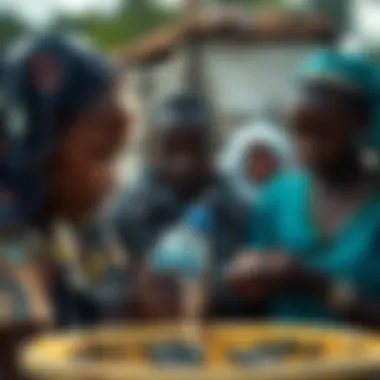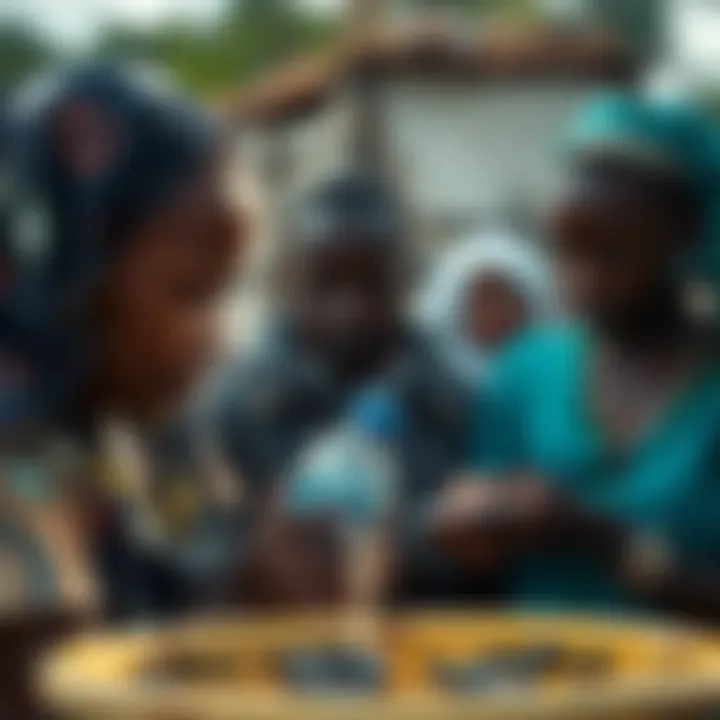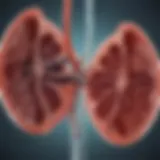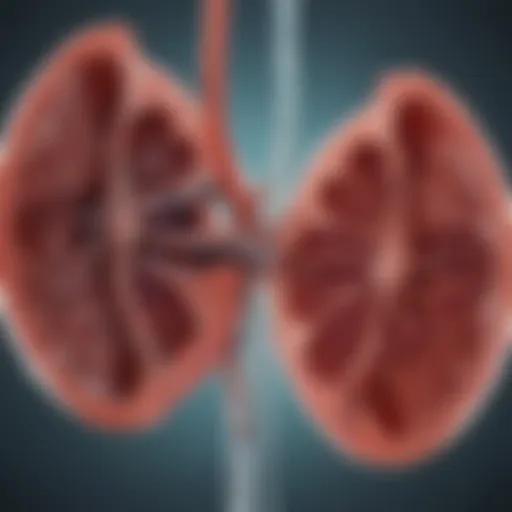Innovative Water Purification Technologies in Africa


Article Overview
Purpose of the Article
Access to clean drinking water in Africa poses a critical issue that needs urgent attention. The intention of this article is to shine a light on the various water purification technologies being utilized across the continent. It also highlights local innovations that are emerging in response to unique circumstances, addressing the barriers that hinder these technologies from being fully effective. By tapping into real-world examples and examining social and economic factors, the article aims to provide a comprehensive understanding of how water purification efforts are evolving within different African contexts.
Relevance to Multiple Disciplines
This topic is not confined to a single realm of study but spans various disciplines including environmental science, public health, economics, and social policy. The urgency of clean water initiatives speaks to a broader audience; from scientists developing advanced purification systems to policymakers focusing on health impacts, and to communities striving for better living conditions. Understanding the nuances of water purification technology in Africa opens pathways for interdisciplinary collaborations that could usher in broader solutions.
Research Background
Historical Context
To truly appreciate the state of water purification technology in Africa today, one must delve into its historical backdrop. Traditionally, many communities relied on natural water sources—such as rivers and springs—that often led to a host of waterborne diseases. The repercussions of colonial practices also played a role in shaping modern water infrastructure. As populations swelled, the need for innovative and sustainable water solutions became more pressing.
Key Concepts and Definitions
Before diving deeper, it’s crucial to clarify several key terms associated with this discussion.
- Water Purification: This refers to the process of removing impurities from water to make it safe for drinking and other uses.
- Point-of-Use Technologies: These are systems designed for individual households or small communities to treat water at the point where it is accessed, rather than at a centralized treatment facility.
- Sustainable Practices: Approaches that not only address immediate needs but also ensure that resources are available for future generations.
Understanding these concepts can offer significant insight into the ongoing conversations about water access and quality in Africa.
"Water is life, and clean water means health."
— World Health Organization
"Water is life, and clean water means health."
— World Health Organization
In considering the future of water purification technology in Africa, this article will explore the unique challenges faced on the ground. From economic constraints to geographical disparities, the path to cleaner water is far from straightforward. Join us as we investigate the innovations that are harnessing local resources, adapting to circumstances, and influencing community development.
Prologue to Water Purification
Water purification sits at the crossroads of health and technology, acting as a beacon of hope in regions where access to clean drinking water is still a distant dream. This pressing issue is especially relevant in Africa, a continent grappling with significant water quality challenges. Understanding water purification is more than just a scientific endeavor; it’s about grasping the profound implications for public health, economic development, and social equity. Without adequate clean water, not only do physical health risks escalate, but communities also experience stunted growth in every regard.
Importance of Clean Water
Clean water serves as the backbone for a variety of essential aspects of life. Here are some vital reasons why it is so important:
- Health Benefits: Access to fresh drinking water dramatically reduces disease transmission. Conditions like cholera, dysentery, and other waterborne illnesses claim hundreds of thousands of lives each year. Ensuring clean water translates to healthier populations, less strain on medical systems, and potentially billions in economic savings.
- Economic Development: Areas with reliable access to clean water can see improved productivity. Communities can shift their focus from survival to growth, investing in education and job opportunities instead of spending limited resources on disease management and healthcare.
- Social Stability: When communities have reliable access to clean water, they foster a stronger sense of unity and social cohesion. Conflicts arising from scarcity often disappear when resources are adequately shared and managed.
In essence, when populations drink contaminated water, they not only jeopardize their health but also diminish the very potential for community and economic growth.
Global Context of Water Quality Issues
Globally, water quality remains a significant concern, with about 2 billion people lacking access to safe drinking water. This crisis is not just an African concern; rather, it reflects broader challenges faced around the world. In regions affected by contamination, chemical runoff, and inadequate infrastructure, the repercussions are dire. Here are some contextual facts:
- Contamination Sources: Industrialization, agricultural chemicals, and urban runoff contribute to the degradation of water quality. Major rivers, lakes, and aquifers are often polluted, complicating any purification efforts.
- Climate Change: Rising temperatures and changing precipitation patterns lead to unpredictable water supply variations and often result in extreme weather events, compounding the existing water quality issues.
- Policy Gaps: Even in countries where clean water is technically available, often the policies governing its distribution are insufficient or poorly executed. Inequality in water access can leave marginalized populations without the basic necessities.
Developing a nuanced understanding of these global factors helps pinpoint not only the challenges on the African continent but also the innovative solutions needed in various contexts. The importance of water purity is universal, and each region offers unique challenges and opportunities. By addressing these through effective technologies and policies, a path forward can emerge, underscoring the global commitment to ensure clean water for all.
Overview of Water Quality in Africa
Access to clean water is a fundamental human right, yet in Africa, millions grapple with this essential need on a daily basis. This section explores the pressing issues surrounding water quality on the continent, highlighting aspects such as current statistics on access, the dire health ramifications of contaminated water, and the critical role this topic plays in understanding wider social and economic challenges.
Current Statistics on Access to Clean Water
Recent data reveals that nearly 400 million people in Africa lack access to safe drinking water, painting a stark picture of the water crisis. Regions such as sub-Saharan Africa are particularly hard hit, where reports show that only about 60% of the population has reliable access to clean water.
- Urban vs. Rural Divide: In urban areas, infrastructure has improved, yet many townships remain underserved. Conversely, rural communities oftentimes rely on surface water, which is susceptible to contamination from agricultural runoff or livestock waste.
- Investment Needs: To address these disparities, estimates suggest an investment of around $50 billion annually will be necessary to upgrade water supply systems and reduce the number of people without access.
"Clean water is not just a commodity; it’s imperative for a healthy society and a thriving economy."


"Clean water is not just a commodity; it’s imperative for a healthy society and a thriving economy."
Impact of Poor Water Quality on Health
The ramifications of poor water quality are profound and far-reaching. Contaminated water sources contribute to a range of preventable diseases. Diarrheal diseases, primarily caused by microbial pathogens in unsafe water, are a leading cause of morbidity and mortality among children under five years old, with an estimated 500,000 children dying each year as a result.
- Cholera and Other Waterborne Diseases: Access to unsafe water can lead to outbreaks of cholera and other waterborne illnesses, challenging existing healthcare systems. Factors like inadequate sanitation and hygiene practices further exacerbate the situation.
- Economic Consequences: Addressing health issues caused by poor water quality incurs significant economic costs. Families lose income when a breadwinner falls ill, and healthcare expenses skyrocket due to a reliance on medical intervention rather than preventative measures.
The statistics and health impacts underscore the urgency for innovative solutions and systemic changes in how water purification technologies are approached across Africa.
Traditional Methods of Water Purification
Water purification has deep roots in various cultures, especially in Africa, where local communities developed methods to ensure their wells and rivers provided safe drinking water. Understanding Traditional Methods of Water Purification is important not only for recognizing historical practices but also for appreciating the base upon which modern technologies build. These methods tap into the knowledge accumulated over generations.
Cultural Practices and Historical Context
In many African communities, traditional purification techniques are steeped in cultural significance. For instance, the use of certain plants like Moringa oleifera has been noted for its ability to flocculate (or clump together) impurities and microbes. Villagers crush the seeds, mixing them with turbid water, letting the matter settle, and then recovering the clearer water above. This is not merely a practical effort; it's also a ritual often tied to community gatherings where oral history and practices are shared.
Moreover, various cultures have passed down traditional filtration processes using sand, clay, or charcoal. Each has a unique role in the purification phase, handmade and often tailored to regional conditions. This historical context shines a light on sustainable practices that respect the environment, making use of available resources without heavy machinery. Understanding these cultural practices enhances our knowledge of how communities can harness their heritage in tackling water challenges today.
Limitations of Traditional Methods
While these techniques are beneficial rresources, they also come with limitations.
- Effectiveness: Traditional methods may not always remove all harmful pathogens, particularly viruses, which often require more advanced purification solutions.
- Scalability: What works in a small village might be inadequate for urban settings where larger populations depend on consistent and safe water supply.
- Time-Consuming: Many traditional practices may take a considerable time to process, which isn't ideal in emergencies.
- Lack of Education: Not all community members might be aware of how to correctly implement these methods, leading to variations in effectiveness.
In summary, while traditional purification methods have a vital role in water safety, their limitations signify an urgent need for combining old wisdom with modern technology to ensure better health outcomes. As we navigate through the innovative approaches being introduced, it becomes clear that merging the old with the new could be the key in overcoming Africa's water quality challenges.
"Traditional approaches, though rooted in culture, must evolve with the times to meet the demands of modern life."
"Traditional approaches, though rooted in culture, must evolve with the times to meet the demands of modern life."
Through continued discussions and research, we can forge a pathway for effective solutions that respect heritage while addressing contemporary challenges.
For further reading on cultural practices of water purification, you can check out resources like Britannica on Water Purification.
Understanding both the strengths and weaknesses of these methods gives us the clarity needed to innovate in ways that honor past wisdom while enhancing community health.
Emerging Water Purification Technologies
Emerging water purification technologies are gaining traction in Africa, where the quest for clean drinking water remains an uphill battle. These advanced methods not only address the immediate need for safe water but also promise sustainability, affordability, and effective scalability. The importance of these technologies cannot be overstated—they present innovative solutions that can potentially turn the tide against waterborne diseases and improve quality of life across communities.
Through the exploration of different systems such as solar purification, bio-sand filters, and nanotechnology, it's apparent that these advancements hold significant benefits:
- Accessibility: Many emerging technologies can be implemented in rural or resource-poor areas, where traditional methods may fall short.
- Cost-Effectiveness: Several of these technologies, particularly solar systems, can drastically reduce operational costs compared to conventional systems.
- Environmental Friendliness: Many innovations involve minimal environmental impact, aligning with broader goals of sustainability.
Solar Water Purification Systems
Solar water purification uses sunlight to distill or purify water. This technology is especially relevant in regions that experience abundant sunshine, making it an attractive option for many African communities. Systems harness sun energy to heat water, evaporating contaminants and letting pure water condense for collection.
- Benefits: Solar systems are largely sustainable, requiring little to no ongoing costs after installation. They operate off-grid, which is vital in areas where electricity is unreliable or non-existent.
- Considerations: The initial setup can be expensive, and the efficiency may fluctuate based on climatic conditions. Despite this, in dry seasons with prolonged sunlight, the results can be remarkable.
"Harnessing the sun's power not only provides clean water but also promotes energy independence in distant communities."
"Harnessing the sun's power not only provides clean water but also promotes energy independence in distant communities."
Bio-Sand Filters
Bio-sand filters are a simple yet effective solution for purifying water using layers of sand and gravel. This system leverages natural processes to eliminate pathogens and sediment. Constructing these filters is straightforward, allowing local artisans to create them using accessible materials.
- Advantages: They're low maintenance and can easily be operated by community members. Additionally, bio-sand filters improve the quality of water not just immediately but over time as the biological layer matures.
- Limitations: They require a consistent source of raw water, and their effectiveness can diminish if not properly maintained. However, when look after, they can provide long-term benefits to households.
Nanotechnology in Water Treatment


Nanotechnology represents the forefront of innovation in water treatment, utilizing materials at the molecular scale to enhance purification processes. This technology can provide solutions for contaminants that traditional filters struggle to handle.
- Approaches: Methods like nano-filtration and using nanoparticles for adsorption of impurities can drastically improve water quality.
- Potential: The potential to remove heavy metals and hazardous chemicals positions nanotechnology as a game changer in challenging waters.
- Challenges: High costs and the need for advanced education and training for local technicians may hinder widespread adoption.
In summary, these emerging water purification technologies—solar systems, bio-sand filters, and nanotechnology—are crafting new pathways for providing clean and safe drinking water in Africa. While challenges exist, the groundwork laid by these innovations is setting the stage for a future where accessibility to safe water becomes a norm rather than an exception.
Challenges in Implementation
Implementing water purification technologies in Africa faces significant hurdles. These challenges can stall progress and undermine the effectiveness of innovative solutions. Addressing these barriers is crucial to ensuring that communities receive clean water, as the solutions are inherently tied to local contexts and needs. This section discusses the main challenges, such as economic barriers, infrastructure limitations, and educational gaps, illustrating their impact on communities and the potential pathways toward a sustainable water future.
Economic Barriers
Financial obstacles often create a substantial roadblock to the adoption of water purification technologies. In many African nations, economic instability limits investments in the necessary infrastructure and technologies. Local governments often lack the funds to procure advanced purification systems or maintain existing ones.
- Limited Resources: Many communities are grappling with competing needs, making it tough to allocate funds specifically for water projects.
- High Initial Costs: Although innovative technologies like solar purifiers or bio-sand filters may offer long-term savings, the initial investment can be prohibitive.
- Microfinancing Opportunities: Some NGOs are beginning to explore microfinancing options, enabling families to invest in purification units but uptake remains low due to a lack of awareness.
Addressing economic barriers takes more than just funding. It involves creating economic incentives that encourage local manufacturers and entrepreneurs to produce affordable solutions, making clean water accessible without breaking the bank.
Infrastructure Limitations
Even the best water purification technology cannot function without a solid infrastructure to support it. In many parts of Africa, inadequate roads and transport systems hinder the delivery of technology and resources. Here are several limitations that need addressing:
- Inexisting Pipelines: Inadequate or damaged water pipelines can render purification systems redundant, as the treated water may not reach households effectively.
- Power Supply Issues: Many innovative purification methods require a reliable power source. With electricity outages common in some areas, reliance on these technologies becomes complicated.
- Maintenance Challenges: Local authorities often struggle to maintain existing infrastructure, leading to a cycle of disrepair that undermines water purification efforts.
By focusing on upgrading existing infrastructure and building new systems, the long-term mission of providing clean water becomes more achievable, as technology can work in tandem with enhanced delivery networks.
Educational Gaps and Community Engagement
Education plays a pivotal role in the successful implementation of water purification technologies. Communities need to be not just consumers but also knowledgeable proponents of these solutions. Unfortunately, educational gaps present their own set of challenges:
- Lack of Awareness: Many community members may be unaware of the benefits of modern purification technologies or how to use them effectively.
- Training Programs: Emerging technologies often require specific knowledge for installation and maintenance, but training programs are rarely widespread.
- Community Involvement: When communities are involved in the decision-making process, there tends to be a higher rate of acceptance and effective usage. Programs that promote local ownership paired with clear educational outreach can be a game changer.
"Investing in education not only uplifts communities but also ensures that clean water solutions resonate with their values and needs."
Case Studies of Successful Implementations
Case studies of successful implementations in water purification are instrumental in understanding how different approaches can tackle the diverse water quality problems across Africa. These case studies illustrate the adaptability of innovative technologies within local contexts, shedding light on the tangible benefits that have emerged from these efforts. By examining these practical examples, readers can grasp the efficacy of various purification methods and the community-centric strategies that bolster their achievements. Moreover, these examples emphasize the importance of local engagement and the unique challenges that varying geographic and socio-economic landscapes present.
Rural Community Initiatives
In rural parts of Africa, where access to clean water can feel like chasing a mirage in the desert, grassroots initiatives have sprung up, showing that change starts with the community. For instance, in Uganda, community-led water purification projects utilize bio-sand filters, a low-tech, cost-effective solution that local residents construct using readily available materials such as sand, gravel, and concrete. This approach not only imparts crucial knowledge on water management to the populace but also fosters a sense of ownership over clean water initiatives.
Another noteworthy example is seen in the rural regions of Kenya, where organizations like the African Development Solutions (ADESO) have developed stone filtration systems. These filters, made from local materials, drastically improve water quality while involving village members in the assembly and maintenance tasks. This community-based model not only results in cleaner drinking water but enhances relationships among residents, as they work together towards common goals.
The critical aspect of these rural initiatives lies in their adaptability. They can be modified to meet specific local needs and conditions, making them not just solutions but also promising pathways for community empowerment and resilience against water scarcity challenges.
Urban Water Management Projects
Shifting focus to urban landscapes, cities like Cape Town are increasingly experimenting with innovative water purification strategies. The recent water crisis there showcased how urban areas must grapple with both population density and dwindling resources. As a proactive response, the municipality implemented desalination plants, which convert seawater to drinking water. Although costly, these projects have sparked discussions on long-term sustainability and alternative sources for essential supplies.
In a different urban setting, Nairobi has engaged in the introduction of membrane bioreactor technologies (MBR). These systems combine conventional wastewater treatment with membrane filtration, allowing the city to recycle water efficiently. Not only does this method help reduce the amount of wastewater entering surrounding lakes and rivers, but it also addresses the growing demands for clean water in a rapidly expanding population.
Moreover, these urban initiatives highlight the role of partnerships among various stakeholders, including government entities, NGOs, and businesses. For example, a collaboration between the city and several international NGOs has facilitated infrastructure improvements that help ensure a stable supply of potable water to disadvantaged areas, demonstrating the importance of shared commitments in tackling urban water challenges.
In summary, whether it’s through grassroots efforts in rural settings or sophisticated technological implementations in urban locales, case studies across Africa reveal that innovative solutions to water purification are as varied as the communities they serve. These narratives not only provide insights into the effectiveness of different approaches but also inspire hope by showcasing what can be done when collective human ingenuity meets resource challenges.
Role of NGOs and Government in Advancing Water Purification
Access to clean water is a fundamental human right, and its management falls significantly on the shoulders of both non-governmental organizations (NGOs) and government bodies. In Africa, the collaboration between these entities plays an instrumental role in not just advancing water purification technologies, but also ensuring sustainable practices. This section examines how these partnerships are formulated, the benefits they bring to communities, and the various considerations that need to be addressed to further enhance water purification efforts across the continent.
Funding and Resource Allocation


Funding is akin to the lifeblood that sustains innovative efforts in water purification. Without adequate resources, even the best ideas can stagnate. NGOs often step in where government funding falters, providing essential financial backing for local projects. For instance, organizations like WaterAid and the International Water and Sanitation Centre actively channel funds into community-driven projects aimed at installing affordable water filters or constructing rainwater harvesting systems. Their contributions help bridge the gap where public funding might be lacking due to economic constraints or bureaucratic hurdles.
Government funding, however, is equally crucial. National and local governments hold the power to allocate significant resources toward water infrastructure projects. They can also implement policies that encourage private sector investment in water purification technologies. A notable example is the national frameworks in Kenya that incentivize water purification ventures, creating an environment where innovation can thrive.
Additionally, international organizations such as the World Bank and the United Nations often collaborate with governments and NGOs to pool resources and expertise. This partnership model can lead to more effective funding strategies, ensuring that even the most marginalized communities are reached.
"Funding not only enables projects but also empowers local voices, ensuring that water solutions are grounded in community needs."
"Funding not only enables projects but also empowers local voices, ensuring that water solutions are grounded in community needs."
Policy Frameworks Supporting Water Purification
Policy frameworks serve as the backbone of effective water management strategies. Strong policies are essential to establish clear guidelines and objectives, particularly in a landscape that varies dramatically from one region to another in terms of resources, needs, and technological advancements. Governments hold a pivotal role in crafting these policies, while NGOs can provide valuable grassroots insights that inform and improve them.
In many African nations, policies such as the National Water Act (for example, in South Africa) lay out comprehensive approaches for water resource management. Such frameworks not only set standards for water quality but also promote collaboration across various stakeholders, including private sectors and local communities. By involving NGOs in policy formulation, the government can draw upon real-world insights that reflect the challenges faced by communities, thus increasing the likelihood of successful implementation.
Moreover, policies that support research and innovation in water technologies can catalyze advancements. Countries like Rwanda are making strides by instituting policies that support the development of solar purification and filtration technologies. These forward-thinking approaches can lead to sustainable outcomes, promoting not just access to clean water, but also resilience against climate change impacts.
Ultimately, for both NGOs and governments to work effectively in advancing water purification, there must be continual dialogue. This includes discussing barriers, sharing successes, and adjusting strategies as necessary. Collaboration can help form a more cohesive approach to tackling the water crisis, creating a united front that enhances the quality of life for millions.
Through efficient resource allocation and robust policy frameworks, the dual role of NGOs and government becomes increasingly pivotal in addressing water purification challenges. Their collective impact, when effectively coordinated, can lead to transformative changes, setting the stage for a future where clean water is no longer a luxury but a standard for all citizens.
Future Directions in Water Purification Technologies
The journey towards improving water purification technologies in Africa is nothing short of critical. As the continent faces ongoing challenges related to water quality, the future holds promise through innovative approaches and sustainable practices. The advancements on the horizon could shift the narrative around clean water access, providing communities with the tools they need to combat waterborne diseases and improve overall well-being. In this section, we will explore the innovations that are emerging alongside the potential for sustainable solutions.
Innovations on the Horizon
Recent strides in technology are paving new pathways for water purification in Africa. Here are some notable innovations that might change the landscape:
- ** microfiltration membranes:** These are being developed for affordable filtration systems suitable for both urban and rural areas. They promise a more efficient removal of pathogens without hefty maintenance costs.
- ** Electrochemical water treatment:** This method utilizes electric currents to purify water, showing potential for higher efficiency in removing contaminants. It's an example of how integrating energy sources can optimize water purification processes.
- ** Affordable UV-C light purification:** Devices powered by solar energy that use UV-C light to disinfect water are gaining traction. This method is both cost-effective and environmentally friendly, addressing the dual challenge of energy accessibility and water safety.
Moreover, the adaptation of mobile applications and internet platforms could facilitate community-driven monitoring of water quality, making localized solutions more effective. By leveraging both traditional knowledge and emerging technologies, there is a unique opportunity to foster a hybrid approach to water purification that resonates with various needs of communities.
Potential for Sustainable Solutions
Sustainability is at the core of any long-term solution regarding water purification and access. Balancing sophisticated technologies with the realities of everyday life in African regions is key. Here are some sustainable methods worth emphasizing:
- Rainwater harvesting systems: This age-old practice is being modernized with innovation. For instance, storage systems integrated with filtration solutions can maximize the use of seasonal rains, ensuring that households have access to clean water throughout the year.
- Community-based filtration: Localized solutions operated and maintained by communities encourage ownership and sustainability. Initiatives such as communal bio-sand filters not only purify but also educate participants about the importance of clean water and health.
- Partnerships with local universities and tech hubs are fostering innovation. These collaborations can help tailor technologies specifically to the challenges faced by local populations.
"Access to clean water is not just a necessity; it's a fundamental human right vital for health, development, and dignity."
— WHO
"Access to clean water is not just a necessity; it's a fundamental human right vital for health, development, and dignity."
— WHO
Further information can be found at Wikipedia on Water Purification and WHO Guidelines for Drinking Water Quality
By investing in these future technologies and fostering community engagement, Africa stands to make significant strides in addressing its pressing water quality challenges.
Culmination
Access to clean water is not just a necessity; it’s a fundamental right, and this article has shed light on the multilayered challenges and innovations concerning water purification technologies in Africa. This may be an ongoing conversation, but it is heartening to see that advancements are cropping up despite significant hurdles. Technology development doesn't happen overnight. However, in examining African contexts, one sees a tapestry of local solutions emerging that align with the unique needs of diverse communities.
Summary of Key Points
- Importance of Clean Water: Clean water is essential for health, productivity, and sustainability.
- Current Water Quality Issues in Africa: Many communities still lack access to safe and clean water, leading to dire health implications.
- Traditional Methods and Their Limits: While traditional purification techniques have deep cultural roots, they lack the efficacy required for modern health standards.
- Emerging Technologies: Innovations like solar water purification and bio-sand filters are giving hope for better solutions.
- Implementation Challenges: Economic factors, poor infrastructure, and lack of community education complicate the deployment of effective technologies.
- Successful Case Studies: Rural and urban initiatives highlight success stories that can serve as blueprints for future efforts.
- Future Directions: Innovations on the horizon indicate a promising path for sustainable solutions.
Overall, the insights gained from technological advancements and community efforts illustrate how collaboration among stakeholders, including governments and NGOs, forms the backbone of progress in water purification.
Call to Action for Stakeholders
To sustain momentum in tackling water challenges, it is crucial for stakeholders to come together and engage actively in this endeavor. Here are actionable steps stakeholders can take:
- Invest in Local Innovations: Fund grassroots initiatives that showcase community-led solutions.
- Enhance Policy Frameworks: Advocate for policies that prioritize water purification technologies and allocate resources accordingly.
- Build Partnerships: Collaboration between governments, NGOs, and local businesses can amplify efforts to improve water quality.
- Focus on Education: Implement programs to educate communities about the importance of water purification and hygiene practices.
- Leverage Technology: Embrace emerging technologies that can be tailored to local contexts, ensuring they are cost-effective and scalable.
By acting with urgency and commitment, we can ensure that every individual in Africa has access to the clean water they deserve. It’s not just an investment in health; it’s an investment in the future of communities across the continent.
"Water is life’s matter and matrix, mother and medium. There is no life without water." — Albert Szent-Györgyi
"Water is life’s matter and matrix, mother and medium. There is no life without water." — Albert Szent-Györgyi



